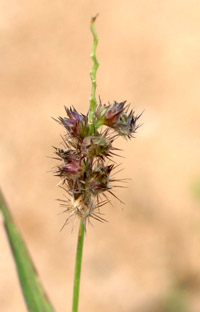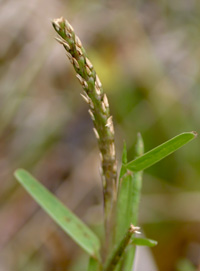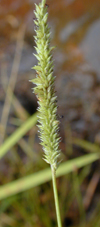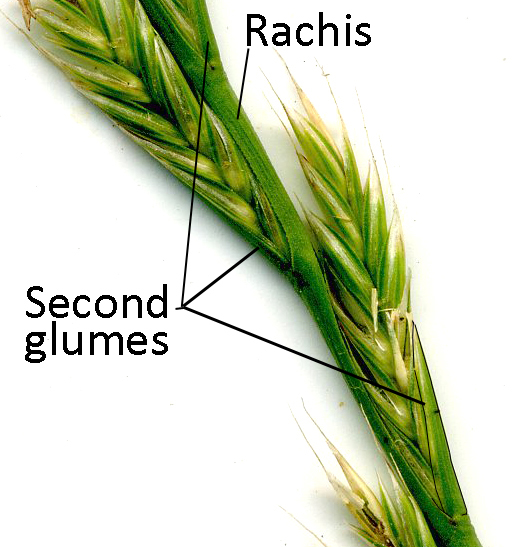|
|
|
[GRASS KEY CONTINUES FROM PAGE 4]
|
|
|
|
|
46a
|
(23) |
Inflorescence a raceme. Spikelets attached by short pedicels to the rachis and armed with straight or hooked bristles (spikelets are burs, easily detaching and clinging to hair or clothing)
|
|
[47]
|
|
46b
|
|
Inflorescence a spike, raceme, or spike-like panicle. Spikelets not armed, not forming burs, but may have (typically) short awns
|
|
[48]
|
|
~~~~ ~~~~~~~~~~~~~~~~~~~~~~~~~
|
|
|
47a
|
(46) |
 Projections on spikelets are hard bristles or spines. Inflorescence a cylindrical raceme up to 2.6 in (7 cm) long, of somewhat widely-spaced and armed, reddish to purplish burs that detach completely, catching on skin or clothing. { small, bunching grass typically found in drier areas, often near the ocean shore (Fig. 10B). Common sandbur, ‘ume‘alu, mau‘u kukū [HAW - NAT]; burgrass, sand-bur [GUM - NAT] [FACU] (see also [49]
Projections on spikelets are hard bristles or spines. Inflorescence a cylindrical raceme up to 2.6 in (7 cm) long, of somewhat widely-spaced and armed, reddish to purplish burs that detach completely, catching on skin or clothing. { small, bunching grass typically found in drier areas, often near the ocean shore (Fig. 10B). Common sandbur, ‘ume‘alu, mau‘u kukū [HAW - NAT]; burgrass, sand-bur [GUM - NAT] [FACU] (see also [49] ) )
Figure 10B. Inflorescence of Cenchrus echinatus with burs (spikelets) shedding from the zigzag rachis.
|
|
|
47b
|
|
Paired spikelets form a small (under 1/8 in or 3 mm long), ovoid bur, armed with short, hooked bristles. Leaf blades stiff, thick, under 1 in (2 cm) long with sometimes wavy margins. Small, clumping annual found on disturbed sites. Bertero goatgrass, bur grass. (Fig. 10F, below) [HAW - NAT]Tragus berteronianus Schult.
|
|
|
~~~~ ~~~~~~~~~~~~~~~~~~~~~~~~~
|
|
|
48a
|
(25) & (46) |
 Inflorescence a thick, single spike-like axis (terminal, sometimes axillary), 1 to 3 in (3-8 cm) long with spikelets inserted in grooves. Leaves blunt-tipped and folded. { small, extensively running grass used widely in lawns in drier areas and naturalized, especially in sandy soils (Fig. 10C). St. Augustine grass, buffalo grass, ‘aki‘aki haole [HAW - NAT] [GUM - NAT]
Inflorescence a thick, single spike-like axis (terminal, sometimes axillary), 1 to 3 in (3-8 cm) long with spikelets inserted in grooves. Leaves blunt-tipped and folded. { small, extensively running grass used widely in lawns in drier areas and naturalized, especially in sandy soils (Fig. 10C). St. Augustine grass, buffalo grass, ‘aki‘aki haole [HAW - NAT] [GUM - NAT]
Stenotaphrum secundatum (Walter) Kuntze
Figure 10C. Thick rachis and leaves of St. Augustine
(Stenotaphrum secundatum) grass.
|
|
|
48b
|
|
Inflorescence spike-like, but rachis not thickened to prominence over spikelets, rather more typically narrow and partly or completely hidden by spikelets
|
|
[49]
|
|
~~~~ ~~~~~~~~~~~~~~~~~~~~~~~~~
|
|
|
49a
|
(48) |
Each spikelet comprising one to three florets, but only one fertile (the others much reduced in size)
|
|
[50] |
|
49b
|
|
Inflorescence an elongate spike of many-flowered spikelets arranged singly up, and pressed against, the culm (See Fig. 10E, below). Lolium sp. (ryegrasses)
|
|
[61] |
|
~~~~ ~~~~~~~~~~~~~~~~~~~~~~~~~
|
|
|
50a
|
(49) |
Grass mat-forming. Inflorescence a spike or spike-like raceme under 6 cm (2.5 in) tall
|
|
[51]
|
|
50b
|
|
Grass clumping, not mat-forming. Inflorescence either a spike, raceme, or spike-like panicle. Leaves not needle-like, wider than 0.1 in (2.5 mm)
|
|
[52]
|
|
~~~~ ~~~~~~~~~~~~~~~~~~~~~~~~~
|
|
|
51a
|
(50) |
 First glume auriculate (winged) at top, forming a shield-like cover over floret. Second spikelet of pair sterile, as a narrow, finger-like appendage opposite spikelet with perfect floret. Leaf blades short and narrow, but not needle-like. { mat-forming by short-noded leafy stolons; a popular lawn grass. Centipede grass, Honan grass [HAW - ORN] [GUM - ORN]
First glume auriculate (winged) at top, forming a shield-like cover over floret. Second spikelet of pair sterile, as a narrow, finger-like appendage opposite spikelet with perfect floret. Leaf blades short and narrow, but not needle-like. { mat-forming by short-noded leafy stolons; a popular lawn grass. Centipede grass, Honan grass [HAW - ORN] [GUM - ORN]Eremochloa ophiuroides (Munro) Hack.
|
|
|
51b
|
|
First glume not winged, produced to a sharp point at tip. Leaves somewhat 2-ranked. Inflorescense a single raceme typically 1/2 in long, but up to 1.75 in (4.4 cm) and projecting (or not) a little above a dense turf of narrow (or even needle-like) leaves (blades under 0.1 in or 2.5 mm across). Shiny spikelets on pedicels about 1/2 spikelet length. { A small, typically, mat-forming (running), decorative or lawn grass. Zoysia grass
|
|
[33] |
|
~~~~ ~~~~~~~~~~~~~~~~~~~~~~~~~
|
|
|
52a
|
(50) |
Inflorescence a compacted panicle, somewhat more spindle-shaped than cylindrical, about 1/2 in (0.5-1.5 cm) wide near the middle, branches short and tending to cluster to one side at each node, but rotating around up the axis. Spikelets compressed and elongated, several times longer than broad, the tips prolonged to a narrow point (acute). { Small, tufted perrenial in disturbed wet forests and pastures above 2800 ft (840 m; Fig. 10A). Sweet vernalgrass [HAW - NAT] [UPL]
|
|
|
52b
|
|
Inflorescence either a spike, raceme, or spike-like panicle. Spikelets rounded (not flattened in section) and twice or less as long as broad
|
|
[53]
|
|
~~~~ ~~~~~~~~~~~~~~~~~~~~~~~~~
|
|
|
53a
|
(52) |
 Inflorescence a narrow (under 0.2 in or 5 mm), spike-like, simple panicle of crowded, awnless, spikelets completely surrounding and concealing the rachis, except perhaps at the base of the panicle, the latter up to 2.8 in (7 cm) long and held well above mostly basal leaves. { Small tufted grass, found in open wet areas (Fig. 10D). Glenwood grass [HAW - NAT] [GUM -IND]
Inflorescence a narrow (under 0.2 in or 5 mm), spike-like, simple panicle of crowded, awnless, spikelets completely surrounding and concealing the rachis, except perhaps at the base of the panicle, the latter up to 2.8 in (7 cm) long and held well above mostly basal leaves. { Small tufted grass, found in open wet areas (Fig. 10D). Glenwood grass [HAW - NAT] [GUM -IND]
Sacciolepis indica (L.) Chase
Figure 10D. Cylindrical spike-like inflorescence
of Sacciolepis indica about twice actual size.
|
|
|
53b
|
|
Inflorescence a long (exceeding 3 in and typically much longer) panicle of small and very crowded spikelets. Dropseeds and rattail grasses. Sporobolus spp.
|
|
[55]
|
|
~~~~ ~~~~~~~~~~~~~~~~~~~~~~~~~
|
|
|
61a
|
(49) |
 Lemmas awned, awns about as long as or slightly longer than the lemma, typically 5 mm (to 8 mm) on upper florets. Leaf blades between 1/8 and 1/4 in across or a little more
Lemmas awned, awns about as long as or slightly longer than the lemma, typically 5 mm (to 8 mm) on upper florets. Leaf blades between 1/8 and 1/4 in across or a little more
|
|
[62] |
|
61b
|
|
Lemmas not awned. Leaf blades narrow, around 1/8 in (4 mm) or somewhat less in width. { Clumping perennial medium-size grass found in pastures and disturbed sites. Perennial ryegrass [HAW - NAT]
|
|
|
~~~~ ~~~~~~~~~~~~~~~~~~~~~~~~~
|
|
|
62a
|
(61) |
 Upper (second) glume as long as spikelet. Florets elliptic to ovate, swollen. { Annual or short-lived clumping perennial, medium or a little larger, found in pastures and disturbed sites but rare (on O‘ahu only). Ryegrass [HAW - NAT]
Upper (second) glume as long as spikelet. Florets elliptic to ovate, swollen. { Annual or short-lived clumping perennial, medium or a little larger, found in pastures and disturbed sites but rare (on O‘ahu only). Ryegrass [HAW - NAT]
|
|
|
62b
|
|
 Upper (second) glume much shorter than spikelet (Fig. 10E). Florets not swollen. { Annual or short-lived clumping perennial, medium or a little larger, found in pastures and disturbed sites as high as 8000-ft elevation. Italian ryegrass [HAW - NAT]
Upper (second) glume much shorter than spikelet (Fig. 10E). Florets not swollen. { Annual or short-lived clumping perennial, medium or a little larger, found in pastures and disturbed sites as high as 8000-ft elevation. Italian ryegrass [HAW - NAT]
Figure 10E. Lolium multiflorum showing several spikelets appressed
to rachis with short upper glumes and florets with short awns.
|
|